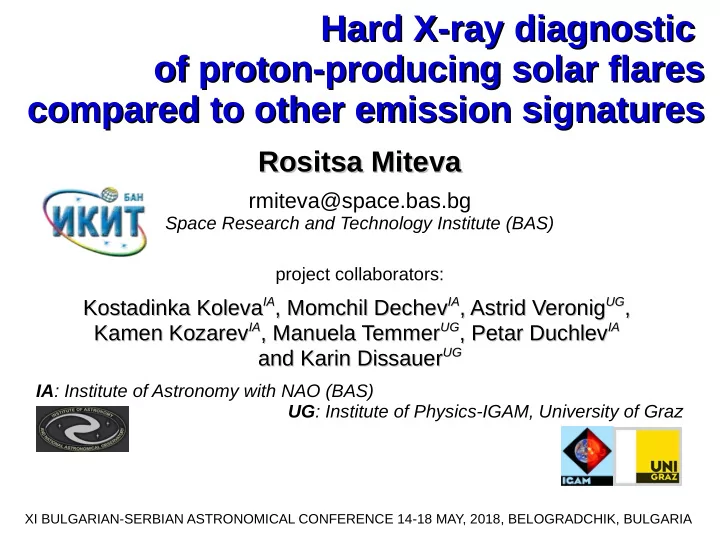

Hard X-ray diagnostic Hard X-ray diagnostic of proton-producing solar flares of proton-producing solar flares compared to other emission signatures compared to other emission signatures Rositsa Miteva Rositsa Miteva rmiteva@space.bas.bg Space Research and Technology Institute (BAS) project collaborators: IA , Momchil Dechev IA , Astrid Veronig UG , Kostadinka Koleva IA , Momchil Dechev IA , Astrid Veronig UG , Kostadinka Koleva IA , Manuela Temmer UG , Petar Duchlev IA Kamen Kozarev IA , Manuela Temmer UG , Petar Duchlev IA Kamen Kozarev UG and Karin Dissauer UG and Karin Dissauer IA : Institute of Astronomy with NAO (BAS) UG : Institute of Physics-IGAM, University of Graz XI BULGARIAN-SERBIAN ASTRONOMICAL CONFERENCE 14-18 MAY, 2018, BELOGRADCHIK, BULGARIA
Acknowledgements This study is part of the project An investigation of the early stages of solar eruptions - from An investigation of the early stages of solar eruptions - from remote observations to energetic particles remote observations to energetic particles [NTS/Austria 01/23 28-Feb-2017] [NTS/Austria 01/23 28-Feb-2017] funded by the National Science Fund of Bulgaria
Introduction: solar flares Introduction: solar flares X4.9 25-02-2014 (00:39 UT)
Introduction: solar flare emission Introduction: solar flare emission flare loop cross-section reconnection site T emmer et al. (2008) precipitating particles Aschwanden book (2002)
Introduction: solar proton events Introduction: solar proton events escaping particles in situ observations Lario & Simnett (2004) ACE & IMP-8 Solar energetic particles (SEPs) protons: MeV–GeV electrons: keV–MeV
Open question: solar origin of SEPs Open question: solar origin of SEPs ➔ single or dual accelerators? flares vs. coronal mass ejections (CMEs) ➔ dominant acceleration process (seed particles from alternative accelerator)? ➔ time-dependent? ➔ event dependent?
Aim: find new diagnostic for proton-related flares Aim: find new diagnostic for proton-related flares non-thermal emission (new alternatives?) thermal emission (what is used in SEP studies) Benz (2002)
Event selection Event selection in situ protons → remote-sensing HXR flare emission (1) List of ~20 MeV in situ SOHO/ERNE proton events in the period: 1996–2017 http://newserver.stil.bas.bg/SEPcatalog/ [~660 events] (2) Identification of the related solar flare: using a set of time, location and intensity conditions [~400 events] (3) Accounting for gaps due to RHESSI data coverage (spacecraft launch in 2002, night-time, South Atlantic anomaly) [~70 events]
Data analysis: hard X-rays Data analysis: hard X-rays ➢ hard X-rays wavelengths: 10–300 keV ➢ EM emission produced by collisions between electrons and ions: bremsstrahlung mechanism (electron scattering in the Coulomb field of ambient ions) ➢ only remote-sensing observations indirectly observations of soft X-ray direct observations of HXRs GOES satellite 1–8 Å (12–1.5 keV) RHESSI satellite 12–25; 25–50; 50–100; 100–300 keV calculate time derivative (so-called Neupert-effect) I) counts/s (approximation) II) photon flux (model dependent!) S. Krucker, ILWS workshop 2006
Data analysis: hard X-rays Data analysis: hard X-rays ➢ hard X-rays wavelengths: 10–300 keV ➢ EM emission produced by collisions between electrons and ions: bremsstrahlung mechanism (electron scattering in the Coulomb field of ambient ions) ➢ ➢ only remote-sensing observations indirectly observations of soft X-ray direct observations of HXRs GOES satellite 1–8 Å (12–1.5 keV) RHESSI satellite 12–25; 25–50; 50–100; 100–300 keV calculate time derivative (so-called Neupert-effect) I) counts/s (approximation)
Data analysis: hard X-rays Data analysis: hard X-rays ➢ hard X-rays wavelengths: 10–300 keV ➢ EM emission produced by collisions between electrons and ions: bremsstrahlung mechanism (electron scattering in the Coulomb field of ambient ions) ➢ only remote-sensing observations directly proxy for HXRs observations of hard X-ray observations of soft X-ray (SXRs) RHESSI satellite GOES satellite e.g. 12–25 keV; 25–50 keV 1–8 Å (12–1.5 keV) I) counts/sec approximation calculate time derivative (so-called Neupert-effect) [II) photon flux convolution] RHESSI browser
Data analysis: hard X-rays Data analysis: hard X-rays ➢ hard X-rays wavelengths: 10–300 keV ➢ EM emission produced by collisions between electrons and ions: bremsstrahlung mechanism (electron scattering in the Coulomb field of ambient ions) ➢ only remote-sensing observations direct observations of HXRs proxy for HXRs comparative test observations of HXRs observations of SXRs data from RHESSI satellite data from GOES satellite 12–25; 25–50; 50–100; 1–8 Å 100–300 keV (12–1.5 keV) HXR counts/sec time derivative
Data analysis: radio wavelengths Data analysis: radio wavelengths Mechanisms ➔ particle acceleration as for HXR/γ-rays ➔ electrons ≈ 100 keV–10 MeV ➔ gyro-synchrotron emission: 2–20 GeV microwaves → proxy for HXRs Data Radio Stations Telescope Network (RSTN); 4 stations, ~24 hr coverage: selection of 15.4 GHz (highest frequency possible) 15.4 GHz
Data analysis: ultraviolet wavelengths Data analysis: ultraviolet wavelengths Data Solar Dynamics Observatory satellite 1600 Å ➔ light curves constructed by spatial integration over the images data after 2010: 22 events
Results: Correlation with proton intensity Results: Correlation with proton intensity Flare emission Correlation coefficients: amplitude flare emission vs. ~20 MeV proton flux (flux/counts/sfu/ [number of events] arbitrary units) All Well-connected/Western SXR 1–8 Å 0.56±0.09 [70] 0.61±0.09 [52] SXR derivative 0.48±0.09 [69] 0.50±0.10 [52] HXR 12–25 keV 0.48±0.08 [70] 0.50±0.10 [51] HXR 25–50 keV 0.50±0.09 [64] 0.50±0.11 [47] HXR 50–100 keV 0.43±0.11 [55] 0.38±0.13 [41] HXR 100–300 keV 0.41±0.12 [34] 0.42±0.13 [28] Radio 15.4 GHz 0.55±0.10 [50] 0.62±0.11 [35] UV 1600 Å 0.50±0.15 [22!] 0.43±0.20 [15!] Correlation coefficients: CME speed vs. ~20 MeV proton flux 0.64±0.08 [65] 0.72±0.07 [50]
Future work Future work We use non-thermal emission signatures (HXRs, microwaves, UV) in correlation studies with in situ proton intensities. Open ?s on the link between flares and SEPs: ➔ Overestimation while using SXR/radio/UV flare emission? ➔ Flare contribution to SEPs only under specific condition (specific magnetic configuration)? Possible directions of research: ➔ Test using HXR flux (model-dependent results) ➔ Test for dependency on proton energy
Recommend
More recommend